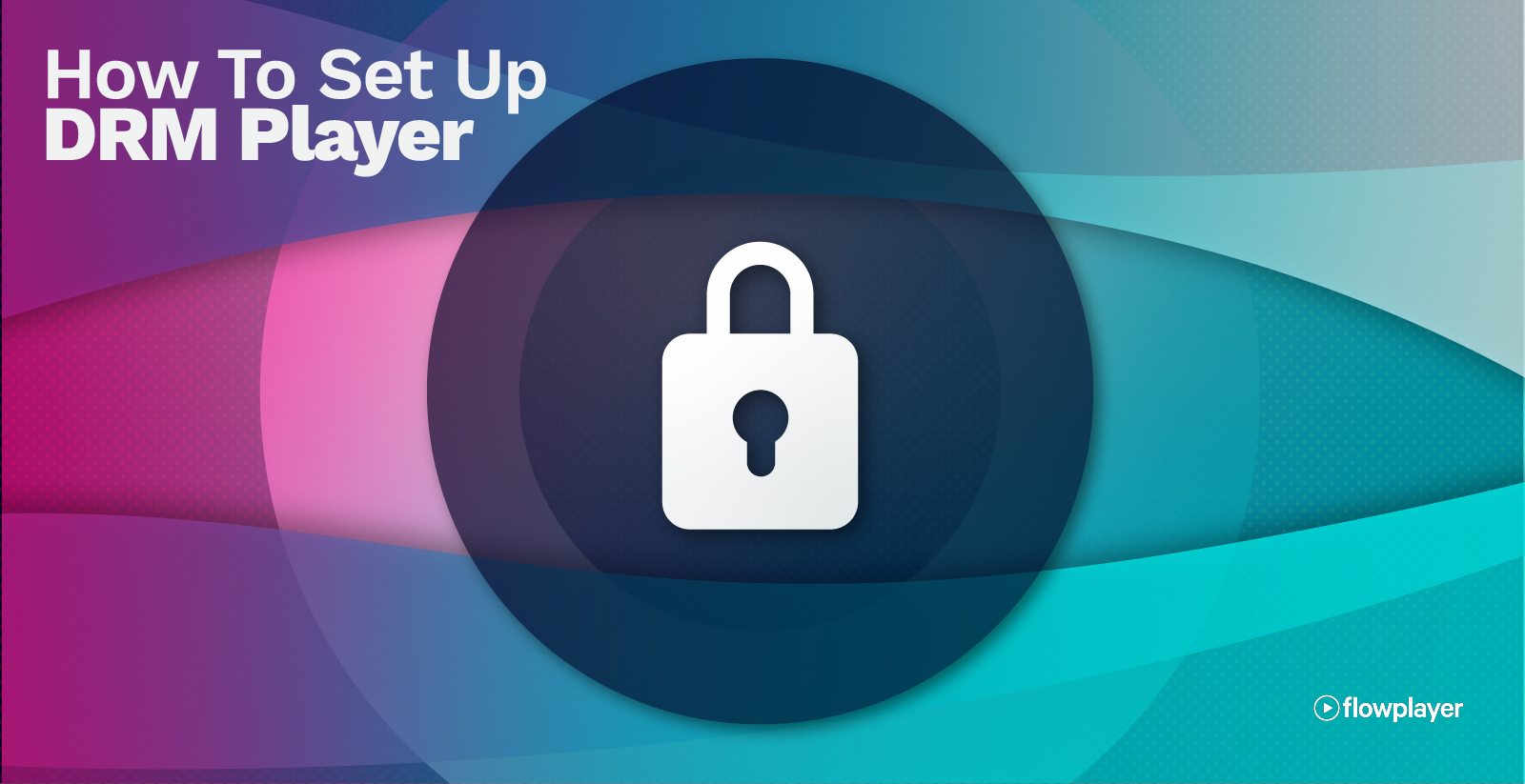

How to Set Up a DRM Player for Secure Video Content

If you create or distribute any original video content on the web, then you know why it’s important to protect your content!
Plenty of people out there will copy your videos, download pirated versions of your content, or attempt to access your videos without permission. The problem is, meaningful subscription or advertising revenue is at stake when your video on demand (VOD) content is unsecured. This applies equally to digital publishers, media houses, broadcasters, and any other enterprise with video content online.
Whether the videos you produce are your primary driver of revenue or just a lead generation tool, video content creation is undoubtedly a big investment. That’s why you need security to ensure you maintain control over where your videos are accessed and by whom.
Enter DRM.
What is DRM?
Digital Rights Management (DRM) is a broad term that describes the technology used to enforce copyright compliance on digital video content online (along with offline media like CDs and Blu-Ray discs).
The idea behind video DRM is to require a licensing key anytime a user attempts to play back a video. This provides much stronger protection against unauthorised viewing of your premium video content.
In plain terms, there are three main components to a video DRM system:
1. Your video content. The actual file of your video, which must be encrypted for DRM.
2. Your video player. The video player serving the video to viewers must be able to decrypt your video.
3. Your license server. To decrypt a video, the video player will request a licensing key and relevant metadata from your license server.
Why You Need Video DRM
By default, many video players will play “clear content,” or content without any DRM protection, which means the videos are easy to copy, share, and redistribute. If you want protected content that can’t be accessed without authorization, then you need DRM built into your video distribution channel.
DRM’s job is to store and transmit videos in an encrypted form that is only decrypted for authorised users or devices. It’s kind of like passing a note to your friend in class using invisible ink, and only someone with a UV light can see what you said.
In practical terms, DRM allows you to control your premium video assets to circumvent piracy and reduce lost revenue from potential viewers or customers.
3 Core DRM Technologies to Know
Unfortunately, video DRM isn’t very straightforward right now. There is no universal encryption/decryption system – each browser and streaming technology uses different standards.
With that said, among the many different DRM technologies you’ll come across, there’s a “big three” of DRM services that will give you the most bang for your buck: Google Widevine, Apple FairPlay, and Microsoft PlayReady.
Yep... those technology companies. If they seem familiar, it’s because of how ubiquitous each one is and the fact that they each use their own DRM system and content decryption module (CDM) on their respective browsers and devices.
So, if you want maximum protection for your videos, then you’ll ideally want your DRM content to be compatible with all three. Let’s take a quick peek at each one before we dive into how you can configure a DRM player for yourself.
1) Google Widevine
Content protected by Google Widevine is playable on Chrome and Firefox web browsers and on Android OS and Chromecast devices. It’s not supported on Chrome for iOS.
Google Widevine supports the streaming protocols MPEG-DASH and HLS.
2) Apple FairPlay
Content protected by Apple FairPlay is playable in the Safari browser on macOS and on iOS devices, including iPhone, iPad, and Apple TV.
FairPlay only supports the streaming protocol HLS.
NOTE: If you choose to use Apple FairPlay, you'll need to apply for an Apple FairPlay certificate from a developer account, which will cost money.
3) Microsoft PlayReady
Content protected by PlayReady is playable on IE11 and Edge web browsers, as well as Xbox devices.
FairPlay only supports the streaming protocol HLS.
BONUS: Clearkey
Another popular encryption interface that works with Flowplayer is Clearkey, which supports the MPEG-DASH content protocol.
For more information on the different protocols supported by Flowplayer, check out our DRM developer plugin page.
How to Set Up DRM Player
So, if you wanted to enable DRM on your video content to work with the 3 most popular DRM technologies, how would you do it?
If you were to handle it on your own, this would involve setting up your own licensing servers and negotiating a licensing option with each technology company.
But knowing the expense and hassle that comes from managing all this, we suggest an easier way: work with a multi-DRM online video platform (OVP) like Flowplayer. This allows you to integrate with all of these DRM technologies with minimal complexity on your part!
Configuring a DRM Player in Flowplayer
If you hop into an enterprise Flowplayer account, you’ll have full-fledged support for a range of DRM options. You also have some other high-level security options within Flowplayer, including geolocation restrictions and tokenised streams.
WIth that said, it may cost extra or require additional services to get fully set up with DRM, and this can vary by customer. Just know that Flowplayer supports virtually any major DRM solution that you may be interested in!
In just one example, Flowplayer has partnered with EZDRM to provide our users with an easy-to-use, cost effective DRM solution. This microservice includes an API integration to provide security for streaming delivery to all standard browsers and mobile devices.
And if you're wondering how it works, Flowplayer’s client JoVE – a creator and publisher of top scientific experiment videos – is a good case in point. JoVE was looking to secure its premium video content. The organisation’s mission during the COVID-19 pandemic was to provide authoritative materials around the coronavirus for free, but it still needed to protect its content.
By utilising EZDRM with Flowplayer, JoVE had the necessary technical framework and flexible business solution to provide fully protected live, on-demand, downloadable, and offline video content services.
Quick DRM Video Protection Definitions
DRM - Digital Rights Management (DRM) is a technological approach to protecting copyrights for digital media by limiting access to only authorised viewers.
CDM - Content Decryption Module (CDM) is the client-side component of DRM, which carries out the decryption of encrypted video content. Popular DRM services with CDMs include Google Widevine, Apple FairPlay, and Microsoft PlayReady.
MPEG-DASH - Moving Picture Experts Group (MPEG) - Dynamic Adaptive Streaming over HTTP (DASH) is a popular adaptive bitrate streaming protocol that breaks down video into smaller chunks at different quality levels.
HLS - HTTP Live Streaming (HLS) is an adaptive bitrate streaming protocol developed by Apple.
CENC - Common Encryption Scheme (CENC) is a standardised encryption method for video content protection that’s been adopted by all of the leading DRM systems. CENC is an ISO 23001-7 standard defining a common format for encrypted video that can then be decrypted for playback on any number of DRM systems.
EME - Encrypted Media Extensions (EME) are a Javscript API that provides a way for browsers to communicate with content decryption modules (CDMs) to implement client-side DRM.
DRM Player Conclusion
In the end, a multi-DRM player is a great way to protect your premium video content and maximise its value to your business. Good DRM solutions will allow you to fully control who sees your videos.
No service is perfect, but with DRM support built right into Flowplayer, plus indispensable features like ad scheduling and adaptive bitrate streaming, there’s virtually no limit to what you can do to create a memorable customer experience, grow your revenue, and solidify your brand reputation.
If you want to learn more about how Flowplayer’s DRM feature works, contact us here. Or to see all of the features in our Enterprise plan, please visit our Plans and Pricing page!